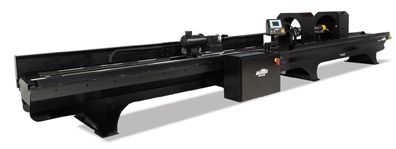Sunnen Offers HTA Series
The HTA Series tube hone offers increased part capacity and stroker torque for bore resurfacing of hydraulic actuators extruder barrels and die casting shot tubes, or manufacture of gas flow meter tubes. Standard models are available for parts from 6.5 ft. (2 m) to 32.8 ft. (10 m) in length, sized in 6.5 ft. (2 m) length increments. All models handle parts with bore ID of 2.5 to 21 inches (63.5 – 533 mm), maximum OD of 24 inches (610 mm), and weights to 8000 pounds (3628.7 kg). The HTA can also be custom-configured for part lengths up to 65.6 feet (20 m), or with a powered section only for unhindered part lengths. Stroker torque capability has been increased by 35 percent over the previous HTA model via a heavy-duty stroker drive gearbox. Width of the steel-impregnated polyurethane belt has been increased from 0.9 inches to 1.9 inches (22 mm to 50 mm), providing a 20:1 safety factor.
The HTA hone is ideal for resurfacing and repair work where light-duty stock removal up to 0.030 inches (0.76 mm) is needed to oversize deeply scratched bores. It is designed for optimum performance with Sunnen ANR275 tooling and abrasives, sold with matching coolants and gauging as part of the machine package. An electronically controlled, 3-hp (2.24 kW), AC gear motor powers the spindle at 20-300 rpm, while the servo-driven stroking system has a speed range of 5 90 ft/min (1.52-27.4 m/min). The all-electric machine eliminates the noise, leaks, valve adjustments and performance variability inherent to hydraulic systems.
Ideal for flow-tube weld cleanup, the HTA hone is ergonomically designed with a moveable operator station and a modular work holding system for rapid setups. It includes a 55-gallon (208 L) coolant reservoir and paper-media coolant filtration unit for better coolant management. Set on casters for easy maintenance, the coolant tank tucks under the machine frame to conserve floor space.
The HTA Series includes high-end features, such as Siemens drives and PLC-control with touch-screen HMI for setting all machine parameters, including stroke reversal point, spindle/stroking speeds, and crosshatch angle calculation. The control features a digital load meter to determine areas of bore tightness, with capability for dwelling the tool in multiple areas to correct part geometry. Other advanced features include automatic tool tensioning, set through the PLC.





